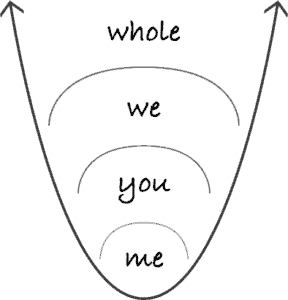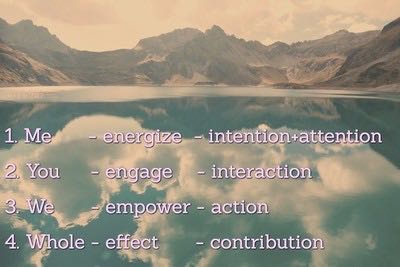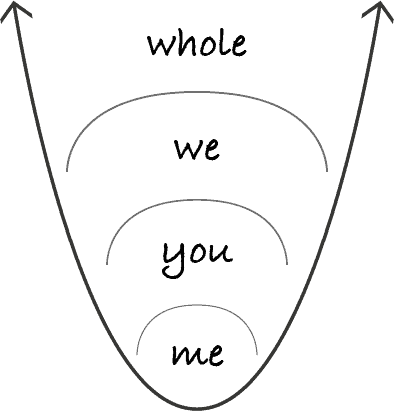
This book-blog covers the basics of how to become a positive agent in any position. In the last post, we have seen the four ways to instigate change that Bob Quin discerns. Using the fourth way, we can become a positive agent.
That can be quite a challenge – so how can we accomplish it? I discern four levels that we need to focus on. Here’s the overview of what I will be blogging about:
Making a positive difference happens from four levels:
1 level: Me, focus on being, energize yourself, work with intention and attention
2 level: You, focus on connect, engage people, work with interaction
3 level: We, focus on collaborate, empower yourself and others, work with action
4 level: Whole, focus on effects, work with contribution

First, help yourself before you can help others. The basis is level 1: me.
We all have homework to do on “me”. If you become whole, and you heal what hurts and hinders you, you can do magic. You will see your personal positive power increase – and that makes a difference.
Sure, you can jump to positive leadership exercises right away, or read how to build a culture where people thrive. But that won’t make a difference if you skip your self-development and awareness homework. Being precedes doing. If you want real change, start with who you are.
With personal positive change you will have a more compelling influence on your team, organization, and beyond.
The ME part will cover the below questions and topics.
PART 1 ME – PRESENCE
How can my presence make a difference?
How to energize myself and be me?
Focus on: Being me and my circle of control
Work on: intention and attention
Topics: positive mindset, energy, mindfulness, autonomy, healing hurts, and hinders, shame and self-compassion
After spending some time on ME, you’ll be probably looking forward to making a connection with one other: YOU.
PART 2. PEOPLE: me and YOU
How to connect with others and be a positive influence?
Focus on: connection with you and my circle of connection
Work with: interaction
Topics: relationship, communication, rapport, compassion
After improving our one-on-one relationships, we’ll look at the level of WE. Here’s the level of multiple relationships and interests, teams, diversity, group dynamics, and so on.
PART 3 PURPOSE – WE
How to collaborate and organize to achieve positive shared goals?
Work with: action
Focus on: teams and my circle of collaboration
Topics: leadership, organization, culture, collective change
Last but not least, we’d like to amplify the positive difference we make to the larger whole.
PART 4 PLANET – WHOLE
How to take the larger whole into account and contribute to a workplace and a world that works for all?
Focus on: whole systems and my circle of concern
Work on: contribution
Topics: my focus of energy and attention, choosing my contribution, inclusion of all (tolerance)
If this looks overwhelming, please bear with me. Rome wasn’t built in a day. I’ll write one blog post at a time and I’ll indicate whether it’s part of the level ME, YOU, WE, or WHOLE.
This is book post #6 – introduction
Here‘s the earlier post.
Here is the next post.
If you’re confused – please start with post #1 or check the Positive Power overview and read the Positive Agent Manifesto.
Leaders, employees, consultants, citizens – everyone can make a positive difference from any position, without needing permission or resources from others. This blog will help you see positive possibilities and (re)claim your positive agency. Unstuck yourself and engage others via your interaction and actions. Transform into a positive organization where people and performance thrive.
I’m blogging my next book: “Positive Power at Work – How to make a positive difference from any position.” Your feedback is appreciated!

2 Responses
Thank you for sharing. It nicely encapsulates a complex process in simple language. It also reminds me of the process Stephen Covey articulated in his book, 7 Habits.. Dependence → Independence → Interdependence. My perception is that the ‘me’ stage is often ignored or only cosmetically addressed in leadership training and development and often, even coaches offer no more than a bag of tricks and ‘how to’ techniques (like the most effective way of giving feedback, managing priorities or resolving conflict etc).
I also agree with the inclusion of ‘healing’ as a crucial step in this blog. It’s an area I am doing some research into as I work on pivoting my coaching practice. At the moment I am working with and reprogramming limiting beliefs (including core beliefs from childhood experiences) with private clients. Soon I’ll be looking into the negative impact they have on our work and professional relationships and developing a few case studies with organisations on the impact this sort of work can have.
That sounds awesome, Baljit! I hope you’re willing to share some of the case studies once they’re ready. Keep up the good work.